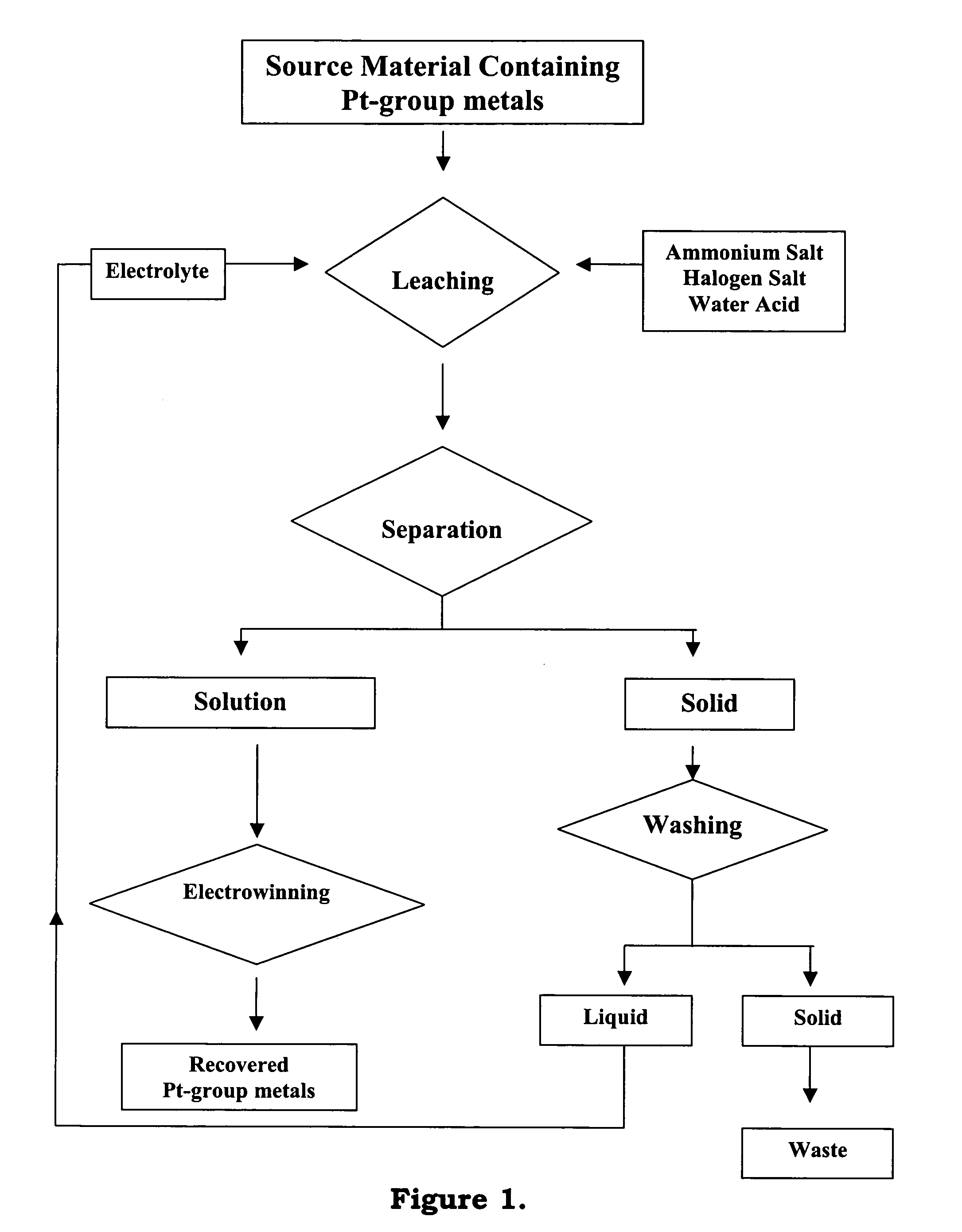Recovery of precious metals
a precious metal and recovery technology, applied in the field of recovery of precious metals, can solve the problems of difficult and expensive safe and efficient handling of reagents, difficult and expensive extraction from various source materials, and chemical strength of reagents
- Summary
- Abstract
- Description
- Claims
- Application Information
AI Technical Summary
Problems solved by technology
Method used
Image
Examples
example i
In this example, the following quantities of the following ingredients were added to a glass reaction vessel.
[0031]
ItemIngredientQuantityA.honeycomb type auto catalysts50gramsB.concentrated H2SO420mlC.ammonium bromide0.4molesD.ammonium iodide0.01molesE.concentrated HNO315mlF.concentrated HCl15mlG.water400ml
[0032]Item A was a ground material passing through a US standard screen of 60 mesh per inch from spent automobile catalytic converters and consisted of 800 ppm of platinum, 260 ppm of palladium and 195 ppm of rhodium imbedded in an alumina-silicate matrix of honeycomb structure.
[0033]A one liter glass reactor vessel was placed on a heating mantle whose temperature was controlled using a rheostat. The reaction temperature was raised to about 90° C. and the reaction was proceeded for about two hours. After the dissolution reaction, the solution was then separated from the solid by filtration.
[0034]The recovery of platinum, palladium and rhodium was evaluated by analyzing the content...
example ii
[0036]In this example, the following quantities of the following ingredients were added to a glass reaction vessel.
[0037]
ItemIngredientQuantityA.dental scrap50gramsB.concentrated H2SO420mlC.ammonium bromide0.4molesD.ammonium iodide0.01molesE.concentrated HNO315mlF.concentrated HCl15mlG.water400ml
[0038]Item A was an incinerated dental scrap ash, all of which is passing through a US standard screen of 60 mesh. It contains typically about 19,000 ppm of gold, 500 ppm of platinum, 1,800 ppm of palladium and about 70 ppm of rhodium.
[0039]A one liter glass reactor vessel was placed on a heating mantle whose temperature was controlled using a rheostat. The reaction temperature was raised to about 90° C. and the reaction was proceeded for about two hours. After the dissolution reaction, the solution was then separated from the solid by filtration.
[0040]The recovery of gold, platinum, palladium and rhodium was evaluated by analyzing the contents of these metals in the solution using an Atomic...
example iii
[0042]In this example, the following quantities of the following ingredients were added to a glass reaction vessel.
[0043]
ItemIngredientQuantityA.gold jewelry scrap type A50gramsB.concentrated H2SO420mlC.ammonium bromide0.4molesD.ammonium iodide0.01molesE.concentrated HNO315mlF.concentrated HCl15mlG.water400ml
[0044]Item A was an incinerated gold jewelry ash, all of which is passing through a US standard screen of 60 mesh. It contains typically about 55,000 ppm of gold, 20 ppm of platinum, and 30 ppm of palladium.
[0045]A one liter glass reactor vessel was placed on a heating mantle whose temperature was controlled using a rheostat. The reaction temperature was raised to about 90° C. and the reaction was proceeded for about two hours. After the dissolution reaction, the solution was then separated from the solid by filtration.
[0046]The recovery of gold, platinum, and palladium was evaluated by analyzing the contents of these metals in the solution using an Atomic Absorption Spectrophot...
PUM
| Property | Measurement | Unit |
|---|---|---|
| temperature | aaaaa | aaaaa |
| temperature | aaaaa | aaaaa |
| temperature | aaaaa | aaaaa |
Abstract
Description
Claims
Application Information
 Login to View More
Login to View More - R&D
- Intellectual Property
- Life Sciences
- Materials
- Tech Scout
- Unparalleled Data Quality
- Higher Quality Content
- 60% Fewer Hallucinations
Browse by: Latest US Patents, China's latest patents, Technical Efficacy Thesaurus, Application Domain, Technology Topic, Popular Technical Reports.
© 2025 PatSnap. All rights reserved.Legal|Privacy policy|Modern Slavery Act Transparency Statement|Sitemap|About US| Contact US: help@patsnap.com


